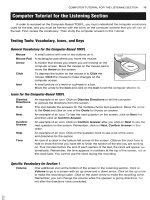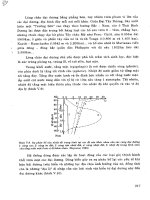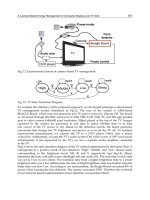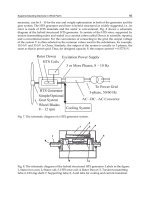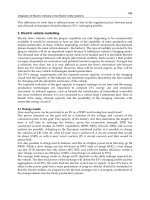Climate Management - Solving the Problem Part 9 ppt
Bạn đang xem bản rút gọn của tài liệu. Xem và tải ngay bản đầy đủ của tài liệu tại đây (209.86 KB, 20 trang )
245
glossary
renewable something that can be replaced or regrown, such as trees,
or a source of energy that never runs out, such as solar energy, wind
energy, or geothermal energy.
resources the raw materials from the Earth that are used by humans
to make useful things.
satellite any small object that orbits a larger one. Artificial satellites
carry instruments for scientific study and communication. Imagery
taken from satellites is used to monitor aspects of global warm-
ing such as glacier retreat, ice cap melting, desertification, erosion,
hurricane damage, and flooding. Sea-surface temperatures and
measurements are also obtained from man-made satellites in orbit
around the Earth.
sequestration carbon storage in terrestrial or marine reservoirs.
Biological sequestration includes direct removal of CO
2
from the
atmosphere through land-use change, afforestation, reforestation,
carbon storage in landfills, and practices that enhance soil carbon
in agriculture.
simulation a computer model of a process that is based on actual facts.
The model attempts to mimic, or replicate, actual physical processes.
sinks any process, activity, or mechanism that removes a greenhouse
gas or aerosol or a precursor of a greenhouse gas or aerosol from the
atmosphere.
spatial resolution (model) the level of detail a model has, referring to
how far apart the x/y points in the grid are spaced. The closer the
spacing, the more data in the model, making it more detailed and
discerning.
sustainable development the concept of sustainable development was
introduced in the World Conservation Strategy (UICN 1980) and
had its roots in the concept of a sustainable society and in the man-
agement of renewable resources.
temperate an area that has a mild climate and different seasons.
thermal something that relates to heat.
tropical a region that is hot and often wet (humid). These areas are
located around the Earth’s equator.
246
Climate management
troposphere the bottom layer of the atmosphere, rising from sea level
up to an average of about 7.5 miles (12 km).
weather the conditions of the atmosphere at a particular time and
place. Weather includes such measurements as temperature, precipi-
tation, air pressure, and wind speed and direction.
further resourCes
books
Christianson, Gale. Greenhouse: The 200-Year Story of Global Warm-
ing. New York: Walker, 1999. Looks at the enhanced greenhouse
effect worldwide after the industrial revolution and outlines the
consequences to the environment.
Dow, Kirstin, and Thomas E. Downing. The Atlas of Climate Change:
Mapping the World’s Greatest Challenge. Los Angeles: University of
California Press, 2006. This publication offers maps and geographic
statistics and information on climate change, global warming, eco-
nomics, and other related scientific topics worldwide.
Friedman, Katherine. What If the Polar Ice Caps Melted? Danbury,
Conn.: Children’s Press, 2002. Focuses on environmental problems
related to the Earth’s atmosphere, including global warming, chang-
ing weather patterns, and their effects on ecosystems.
Gelbspan, Ross. The Heat Is On: The High Stakes Battle over Earth’s
Threatened Climate. Reading, Mass.: Addison Wesley, 1997. This
work offers a look at the controversy environmentalists often face
when they deal with fossil fuel companies.
Harrison, Patrick “GB,” Gail “Bunny” McLeod, and Patrick G.
Harrison. Who Says Kids Can’t Fight Global Warming. Chatta-
nooga, Tenn.: Pat’s Top Products, 2007. Offers real solutions that
everybody can do to help solve the world’s biggest air pollution
problems.
Houghton, John. Global Warming: The Complete Briefing. New York:
Cambridge University Press, 2004. This book outlines the scien-
tific basis of global warming and describes the impacts that climate
change will have on society. It also looks at solutions to the problem.
Langholz, Jeffrey. You Can Prevent Global Warming (and Save Money!):
51 Easy Ways. Riverside, N.J.: Andrews McMeel Publishing, 2003.
247
248
Climate management
Aims at converting public concern over global warming into positive
action to stop it by providing simple, everyday practices that can eas-
ily be done to minimize it, as well as save money.
McKibben, Bill. Fight Global Warming Now: The Handbook for Tak-
ing Action in Your Community. New York: Holt Paperbacks, 2007.
Provides the facts of what must change to save the climate. It also
shows how everyone can act proactively in their community to
make a difference.
Pringle, Laurence. Global Warming: The Threat of Earth’s Changing
Climate. New York: SeaStar Publishing Company, 2001. Provides
information on the carbon cycle, rising sea levels, El Niño, aerosols,
smog, flooding, and other issues related to global warming.
Ruddiman, William F. Earth’s Climate: Past and Future. New York: W.
H. Freeman and Company, 2001. Takes a detailed look at the his-
tory of the Earth’s climate and the forces that have shaped it over
time.
Thornhill, Jan. This Is My Planet—the Kids Guide to Global Warm-
ing. Toronto, Ontario: Maple Tree Press, 2007. Offers students the
tools they need to become ecologically oriented by taking a com-
prehensive look at climate change in polar, ocean, and land-based
ecosystems.
Weart, Spencer R. The Discovery of Global Warming (New Histories
of Science, Technology, and Medicine). Cambridge, Mass.: Harvard
University Press, 2004. Traces the history of the global warming
concept through a long process of incremental research rather than
a dramatic revelation.
journaLs
American Wind Energy Association. “Wind Energy and Climate
Change: A Proposal for a Strategic Initiative” (October 1997).
Available online. URL: />anthologies/energy/wind.html. Accessed March 20, 2009. Discusses
cost-effective methods for supplying electricity to rural villages via
renewable wind energy.
249
Further Resources
Broder, John M. “Democrats Unveil Climate Bill.” New York Times
(4/1/09). Available online. URL: />us/politics/01energycnd.html?hp. Accessed January 23, 2009. Presents
the viewpoint of global warming and politics.
———. “EPA Clears Way for Greenhouse Gas Rules.” New York Times
(4/18/09). Available online: URL:
18/science/earth/18endanger.html. Accessed May 28, 2009. This pres-
ents the new ruling by the EPA in an effort to control greenhouse gases.
Choi, Charles Q. “The Energy Debates: Clean Coal.” LiveScience
(12/5/08). Available online. URL: www.ivescience.com/environ-
ment/081205-energy-debates-clean-coal.html. Accessed February
22, 2009. Discusses whether or not the clean coal technology per-
forms up to its expectations.
Dean, Cornelia. “The Problems in Modeling Nature, with Its Unruly
Natural Tendencies.” New York Times (2/20/07). Available online.
URL:
Accessed May 2, 2009. Discusses the inherent limits of mathemati-
cal models and appropriate assumptions concerning their usage.
Flook, Simon. “China Set to Build 562 New Coal Plants—Kyoto in
Perspective.” The Politic (1/17/07). Available online. URL: www.the-
politic.com/archives/2007/01/17/china-set-to-build-562-new-coal-
plants/. Accessed January 16, 2009. Discusses air pollution concerns
in China and the disastrous effect that will have on global warming
if they do not use renewable energy sources, but rely on fossil fuels
instead as they industrialize.
Gelling, Peter, and Andrew C. Revkin. “Climate Talks Take on
Added Urgency after Report.” New York Times (12/3/07). Accessed
online. URL: www.nytimes.com/2007/12/03/world/asia/03bali.
html?pagewanted=pring. Accessed January 23, 2008. Discusses the
need to cut greenhouse emissions in preparation for the Bali confer-
ence, which will discuss what the global plan of action will be after
the Kyoto Protocol expires in 2012.
Greinel, Hans. “Japan to Fight Global Warming by Pumping Car-
bon Dioxide Underground.” USA Today (6/26/06). Available
250
Climate management
online. URL: />Places,%20Geography/Countries/Norway/48. Accessed April 25,
2009. Explores the option of carbon sequestration as a viable way to
counteract the effects of global warming.
Houghton, R. A., J. L. Hackler, and K. T. Lawrence. “The U.S. Carbon
Budget: Contributions From Land-use Change.” Science (7/23/99)
285, no. 5,427: 574–578. Discusses how the net carbon flux related
to U.S. lands offsets 10 to 30 percent of the United States’ fossil fuel
emissions.
Kanter, James. “Europe May Ban Imports of Some Biofuel Crops.”
New York Times (1/15/08). Available online. URL: www.nytimes.
com/2008/01/15/business/worldbusiness/15biofuel.html. Accessed
March 24, 2009. Discusses which crops the European Union will
not import and why they feel those crops add to the problem of
global warming, not solve it.
Kaufman, Leslie. “Dissenter on Warming Expands His Campaign.”
New York Times (4/10/09). Available online. URL: www.nytimes.
com/2009/04/10/us/politics/10morano.html?pagewanted=print.
Accessed May 28, 2009. Discusses why it is important when read-
ing about global warming to make sure the source is reliable and
believable.
Kerr, Richard A. “Global Warming: Rising Global Temperature,
Rising Uncertainty.” Science (4/13/01) 192–194. Looks at climate
modeling and the uncertainties currently associated with it. It also
discusses important rules to understand when interpreting climate
models.
Krauss, Clifford. “As Ethanol Takes Its First Steps, Congress Pro-
poses a Giant Leap.” The New York Times (12/18/07). Available
online. URL: www.nytimes.com/2007/12/18/washington/18ethanol.
html?pagewanted=print. Accessed January 23, 2008. Discusses the
plans Congress has for renewable energy in order to reduce the
nation’s heavy reliance on foreign oil.
LaGesse, David. “The PC’s Dirty Little Secret: It Wastes Power Shame-
lessly.” U.S. News and World Report (4/17/08). Available online.
251
Further Resources
URL:
2008/04/17/the-pcs-dirty-little-secret-it-wastes-power-shamelessly.
html. Accessed May 9, 2009. This review discusses the real energy
use of a PC and easy practices that can be followed to conserve
energy and lower power bills.
———. “Small Moves You Can Take at Home to Conserve.” U.S. News
and World Report (4/17/08). Available online. URL: http://www.
usnews.com/articles/business/technology/2008/04/17/small-moves-
you-can-take-at-home-to-conserve.html. Accessed May 9, 2009.
Discusses simple ways to save money on electricity, such as prod-
ucts like the Kill A Watt, the Energy Detective, the Bye Bye Standby,
the Solatube, and the Voltaic Generator.
Lavelle, Marianne. “Conservation Can Mean Profits for Utilities.”
U.S. News and World Report (4/17/08). Available online. URL:
/17/conservation-can-mean-profits-for-utilities.html. Accessed
May 9, 2009. Discusses a new trend that encourages utility com-
panies not to expand, but instead to urge customers to conserve
energy.
———. “Three Ways Businesses Can Save on Power.” U.S. News and
World Report (4/17/08). Available online. URL: ews.
com/articles/business/technology/2008/04/17/three-ways-businesses-
can-save-on-power.html. Accessed May 9, 2009. Discusses practical
methods that factories and offices can use to become more energy
efficient and save money.
———. “Green, Not Sacrifice, Is the Political Word.” U.S. News and
World Report (4/17/08). Available online. URL: ews.
com/articles/business/technology/2008/04/17/green-not-sacrifice-
is-the-political-word.html. Accessed May 9, 2009. Discusses the per-
ception today of the environmentalism movement focusing more on
the positive aspects of being green instead of changes being viewed
negatively as a personal sacrifice.
Mankiw, N. Gregory. “One Answer to Global Warming: A New
Tax.” New York Times (9/16/07). Available online. URL: www.
252
Climate management
nytimes.com/2007/09/16/business/16view.html?pagewanted=print.
Accessed April 22, 2009. Provides information on business options
to impose a new tax to combat global warming that would fairly
tax citizens, leaving the distribution of total tax burden basically
unchanged.
New York Times. The “Winners and Losers in a Changing Cli-
mate.” (4/2/07). Available online. URL: imes.
com/2007/04/02/us/20070402_CLIMATE_GRAPHIC.html.
Accessed May 13, 2009. Discusses which countries will be hit the
hardest with the negative effects of global warming and will have
the most adjusting to do. It also gives examples of what some
countries are already doing to mitigate the future effects of global
warming.
———. “The Scientists Speak.” (11/20/07). Available online. URL:
Accessed May 25, 2009. This editorial discusses the latest scien-
tific evidence and why it needs to be used by Washington to set
forth climate policy that deals effectively with the issue of global
warming.
———. “The One Environmental Issue.” (1/1/08). Available online.
URL: www.nytimes.com/2008/01/01/opinion/01fuel.html?page
wanted=print. Accessed January 23, 2008. Gives an overview of how
the global warming issue was dealt with politically in the past and
how it is being looked at today and why.
Reuters (London). “Multinationals Fight Climate Change.” New
York Times (1/21/08). Available online. URL: imes.
com/2008/01/21/business/21green.html. Accessed 4/26/09. Looks at
the joint efforts of 11 companies using renewable energy.
Revkin, Andrew C. “A New Middle Stance Emerges in Debate
over Climate.” New York Times (1/1/07). Available online. URL:
/>r=2&oref=slogin. Accessed May 25, 2009. Presents the opinion of a
new group on the state of global warming that is neither far left or
right, but the middle ground.
253
Further Resources
———. “Connecting the Global Warming Dots.” New York
Times (1/14/07). Available online. URL: imes.
com/2007/01/14/weekinreview/14basics.html. Accessed January
15, 2009. Discusses the anthropogenic contributions to global
warming.
Rosenthal, Elisabeth, and Andrew C. Revkin. “Science Panel Calls
Global Warming ‘Unequivocal’.” New York Times (2/3/07). Avail-
able online. URL: />earth/03climate.html. Accessed May 25, 2009. Compares the force
and certainty the IPCC’s fourth report is written with to their ear-
lier reports and the accelerated seriousness of the global warming
issue.
Sachs, Jeffrey D. “Keys to Climate Protection.” Scientific American
(April 2008). Available online. URL: entificamerican.
com/article.cfm?id=technological-keys-to-climate-protection-
extended. Accessed May 28, 2009. Discusses why the creation and
implementation of new technology is critical to fight global warm-
ing with before it is too late.
Stolberg, Sheryl Gay. “Bush Sets Greenhouse Gas Emissions Goal.”
New York Times (4/17/08). Available online. URL: http://www.
nytimes.com/2008/04/17/washington/17bush.html. Accessed May
25, 2009. Discusses the action that needs to be taken to avoid the
worst of the greenhouse effect and global warming.
Thompson, Andrea, and Ker Than. “Timeline: The Frightening
Future of Earth.” LiveScience. (4/19/07). Available online.
URL: www.livescience.com/environment/070419_earth_time-
line.html. Accessed May 13, 2009. Presents future predictions as
to what the Earth’s environment will be like from now until the
22nd century.
Wald, Matthew L. “New Ways to Store Solar Energy for Nighttime
and Cloudy Days.” New York Times (4/15/08). Available online.
URL: />html. Accessed March 22, 2009. Discusses innovative ways to cap-
ture the Sun’s heat via solar thermal systems.
254
Climate management
Weber, Elke U. “Experienced-based and Description-based Percep-
tions of Long-term Risk: Why Global Warming Does Not Scare Us
(Yet).” Climatic Change (2006) 77: 103–120. Discusses how people
in general look at risk and how they prioritize decisions based on
that perceived risk.
255
Index
Italic page numbers indicate illustrations
or maps. Page numbers followed by c
denote chronology entries; page numbers
followed by t denote tables, charts, or
graphs.
a
accuracy, balance v. 98–99
ACES. See American Clean Energy and
Security Act of 2009
action, taking 183–184. See also solutions
active solar systems 133
adaptation 23, 28–30, 198–199
adaptive management 177
Advisory Group on Greenhouse Gases
(AGGG) 76
aerosols 173
agriculture 29, 89, 112–113
Ahrenkilde-Hansen, Pia 18
airlines 200t
air pollution 123, 126–127
albedo 73, 165
Alley, Richard B. 118
allowance-based markets (cap and trade)
59–60
American Clean Energy and Security Act
of 2009 (ACES) 35, 52–53
Angel, Roger 195–196
Annex I countries 7–9, 12, 13, 57, 58
Annex II countries 8
Antarctic Ice Sheet 213, 234c, 236c
anthropogenic emissions 2–4, 25–28, 31,
179
appliances, household 191, 201t–202t
AR4. See Fourth Assessment Report of the
IPCC
Arctic ecosystem 73–75
Árnason, Bragi 84, 86
Arrhenius, Svante 233c
Arsonval, Jacques-Arsène d’ 154
assigned amount units (AAUs) 58
Atlantic Ocean conveyor belt 27. See also
thermohaline circulation
atmosphere general circulation models
(AGCMs) 170t
Australia 18, 43, 89
automobiles 80–81, 84–86, 186–190
automotive maintenance 200t
aviation emissions 80
B
Baker, James 98
balance, journalistic 97–100
Ban Ki-Moon 90
Barroso, José Manuel 82
Bebb, Adrian 151
Becquerel, Edmund 134
beef 209t
believers in global warming 116–121,
120t–121t
Benn, Hilary 17
binary power plant 141
biodiesel 149
biodiversity loss 29
biomass 46–48, 148–152, 157–158, 158
biopower 148–152
birds 145
black carbon 157
Black Sunday 233c
Boston, Massachusetts 5
Boxer, Barbara 48
Brady, Aaron 47
Brown, Gordon 83
Bureau of Land Management, U.S. (BLM)
125–126
Bush, George H. W., and administration 8
Bush, George W., and administration
Consolidated Appropriations Act of
2008 49
Kyoto Protocol 9–10, 12, 15–18
renewable energy programs 124–125
silencing of critics 96
skepticism on climate change 237c
C
California 62, 64–66, 144
California Air Resources Board (CARB)
65
California Climate Bill 65
Callendar, Guy S. 234c
256
Climate management
Canada 5, 88
Canada Bay, Australia 89
Canadian Wildlife Service (CWS) 73
cap and trade 55–62
and ACES 53
allowance-based markets 59–60
carbon credits 60t
economics of 61–62
Kyoto Protocol 12–13
Lieberman-McCain proposal 237c
project-based markets 57–59
car(s). See automobiles
Car Allowance Rebate System (CARS)
186–188, 188t–189t
carbon capture and storage (CCS)
ACES funding 36
artificial tree proposal 197
DOE research 155–156
Iceland 86
Japan 87–88
Norway 86–87
U.S. research needs 192
carbon credits 12–13, 59–60, 60t, 191–
192
carbon dioxide (CO
2
)
from deforestation 191
ice core studies 235c
and IPCC Working Group reports 26,
27, 31
Kyoto Protocol reduction commitments
8
levels (1800–1870) 233c
levels (1950–1970) 234c
levels (2003) 237c
from peat destruction 151
persistence in atmosphere 186
and skeptics’ argument against global
warming 112
and temperature 214t
and unknowns in climate modeling 180
Carbon Disclosure Project 184
carbon flux 112
Carbon Sciences 157
carbon sinks 112
carbon storage 212
carbon tax 70
Carter, Rob 112–113
Cash for Clunkers (Car Allowance Rebate
System) 186–188, 188t–189t
CCS. See carbon capture and storage
Central Europe floods (2002) 236c
Chandler, Mark 171
chaos theory 174
Charlson, Robert 178
Chevy Volt 189
Chicago, Illinois 5
China 12, 15, 18, 218–219, 237c
chlorofluorocarbons (CFCs) 77
Chukchi Sea 217
cirrus clouds 175–176
Clapp, Philip 17
Claussen, Eileen 86
Clean Air Act 45, 46, 48, 50
Clean and Diversified Energy Initiative
(CDEi) 67
clean development mechanism (CDM) 13,
57–58
Clear Skies and Global Climate Change
Initiatives 15–16
Climate Action Network of Australia 43
Climate Change Action Plan (London,
England) 90
climate investment funds (CIFs) 20
climate modeling 159–181, 166
aerosols and 173
clouds and 173–176
Community Climate System Model
220–222
confidence and validation 171–172
educational programs 171
error amplification 177–178
fundamentals of 162–172, 166, 170t
and GHGs 4
history of 160–162, 163t
Met Office Hadley Centre
configurations 170t
midlevel warming problem 107–108
modeling the response to change
165–167
nature’s inherent unruliness 176–177
“petascale” computer modeling 220–
221
physics of 164
simplifying the climate system 164–165
solar variability 172–173
testing of models 169
uncertainties and challenges 172–181
unknowns 180–181
Climatic Research Unit (University of East
Anglia) 105
climatologists 160
Clinton, Bill, and administration 9, 14, 18
clotheslines 203t
clothing 208t
clouds 161, 162, 173–176, 196
CO
2
. See carbon dioxide
257
Index
coefficients 176
Community Climate System Model
(CCSM) 220–222
community education 206–207
computer modeling 160–161, 163, 219–
220. See also climate modeling
computers, energy saving with 206t
Conference of the Parties (of UNFCCC)
9
confidence, degrees of 25
Congress, U.S. 8, 46, 48–49, 192. See also
Senate, U.S.
Connolley, William 100–101
Consolidated Appropriations Act of 2008
49–51, 51t
controversy over global warming. See
debate over global warming
Copenhagen Conference on Climate
Change (2009) 70, 238c
corn 47–48
Corzine, Jon 83
cryogenic coolers 155
cultural values 92–95
D
dams 146–147, 153
Davies, Kert 99
Davis, Gray 65
debate over global warming 103–121
believers on far left 116–121
middle ground 115–116
modern climate consensus 104–109
skeptics on far right 109–115
deforestation 191, 234c
degrees of confidence 25
“Democrats Unveil Climate Bill” (New
York Times article) 35
Denmark 144
developing countries 12, 15, 217
direct-fired biopower 148–149
DOE. See Energy, U.S. Department of
Doniger, David 17
drought 26, 28, 30, 234c, 236c–237c
Duke Energy Corporation 45
dust bowl 233c
dynamic processes 165
E
Earth Summit 1992 (Rio de Janeiro) 8,
235c
Earth Summit 2002 (Johannesburg) 78
EAUs (EU allowance units) 13
ecological footprint 2, 182
economic issues
benefits of green energy 125–128
and Bush administration’s alternatives
to Kyoto 16
cap and trade 61–62
mitigation projects 68–71
education 171, 206–207
Educational Global Climate Model
(EdGCM) 171
election of 2000 32–33
election of 2008 34–35
electric cars 189
electricity generation/distribution
geothermal 141
modernization 190
pyrolysis oil 150
solar power 134–136
wind energy 142–146, 143
emergent qualities 164
emigration 44
emission reduction units (ERUs) 58
emissions trading schemes. See European
Union Greenhouse Gas Emissions
Trading System
endangered species 148, 151
Energy, U.S. Department of (DOE) 67, 88,
126, 136, 192
energy balance models (EBMs) 167
energy budget 174, 175
energy efficiency 190–191, 201t–204t
ENERGY STAR
®
program 191, 238c
energy use 123
enhanced greenhouse effect 234c
Entman, Robert 98
Environmental Action Plan (California)
62, 64
Environmental Defense Fund (EDF) 57
Environmental Protection Agency, U.S.
44–46, 49–51, 126
Essential Requirements for Mandatory
Reporting (ERMR) 66
ethanol 46–48, 149, 157
EU ETS. See European Union Emissions
Trading System
Europe 106–107, 151–152, 237c
European Climate Change Programme
(ECCP) 79–82
European Commission 78–81
European Union (EU) 151, 211
European Union Greenhouse Gas
Emissions Trading System (EU ETS) 13,
59, 79–80
experiments, climate modeling 160
258
Climate management
extinctions 29. See also endangered
species
extreme weather events 106–107
f
Fairness and Accuracy in Reporting
(FAIR) 97
feedback 160, 174
Fein, Jay 221
finite pool of worry hypothesis 94
First Assessment Report (FAR) 22
Flannery, Mark 46
flash tank 141
flooding 29–30, 107, 218, 236c
food production 28, 47–48, 209t. See also
agriculture
food shortages 28–29, 42
forcings 23, 163
forests 191–192
fossil fuels 151, 237c
Fourier, Jean-Baptiste-Joseph 103, 233c
Fourth Assessment Report of the IPCC
(AR4) 3, 25–31, 90, 117–118, 178–179,
237c–238c
Framework Convention on Climate
Change 235c, 236c
free market 16
freshwater 40–43, 181
fuel cell vehicles 84–86
fuel efficiency 53–54, 80–81, 186, 187
future issues 210–222
futures market 60
g
G-8 countries 19–20, 20t, 237c
gasification 149, 157–158
gasoline price shock (2008) 94
general circulation models (GCMs) 167–
172, 170t
General Motors 189
geochemistry 23
geoengineering 193–198, 194
geological carbon sequestration. See
carbon capture and storage
Geostationary Meteorological Satellite-5
(GMS-5) 175
geothermal energy 85, 139–142, 140
Germany 17, 144
GHGs. See greenhouse gases
Gislason, Sigurdur Reynir 86
glacial melt 5, 26, 28, 218
Global Change Research Program, U.S.
216
global climate computer model (GCCM)
171
global cooling 100–101
global dimming, artificially induced
193–194
Global Effects of Environmental Pollution
Symposium (Dallas, 1968) 75
Global Warming Pollution Reduction Act
of 2007 48–49
global warming potential (GWP) 118
Global Warming Wildlife Survival Act 49
Goddard Institute for Space Studies (GISS)
104, 105, 171, 213–214
Gore, Al
election of 2001 32–33
An Inconvenient Truth 33, 237c
Kyoto Protocol 14
National Journal attack on 111
Nobel Peace Prize (2007) 185, 238c
on renewable energy 69–70
Sanders-Boxer bill 48
Grandia, Kevin 100
Great Britain 17
Great Plains Synfuels Plant (Beulah, North
Dakota) 88
“green carbon” 156–157
green energy
ACES 35
biomass 148–152
California legislation 65–66
congressional funding priorities 192
electricity production 190
environmental benefits 122–130
geothermal 139–142, 140
Gore proposals 69–70
hydropower 146–148, 147
Iceland 84
ocean energy 152–155
solar energy 130–139, 131, 132, 135
wind energy 142–146, 143
greenhouse effect 103, 175, 233c–235c
greenhouse gases (GHGs). See also specific
gases, e.g.: carbon dioxide
and ACES 52–53
and Consolidated Appropriations Act
49–50, 51t
current legislation 44
emissions by country 14t
emissions by sector 63t
from energy production 123
EU reduction recommendations 211
and general circulation models 168
government inaction on 33
259
index
Iceland’s per capita emissions 84
and IPCC Working Group reports
24–25, 31
and Kyoto Protocol 8–10
legislative proposals 35
and nighttime temperatures 4
non-CO
2
157
per capita responsibility, worldwide 218
and Sanders-Boxer bill 48–49
and UNFCCC 6–8
Greening Earth Society 110, 112
Greenland ice core studies 235c, 236c
Greenland ice sheet 213
Gregoire, Chris 66
grocery bags 209t
gross domestic product (GDP) 31, 61, 187
groundwater 140
Group of 8 (G-8). See G-8 countries
Gulf Stream 41–42
Gutzler, David 179
h
Hansen, James E. 72–73, 104
health costs of air pollution 126, 127
heat waves 5, 27, 30, 106–107, 237c
Hegerl, Gabriele 3
Heiligendamm Summit (2007) 19–20
Hill, Antonio 70–71
hindcasting 169
Holdren, John P. 118
home, actions to mitigate global warming
201, 201–204
home energy audits 191
home heating, geothermal for 140–141
Houghton, R. A. 112
Howard, John 18
Huber, Peter 112
Hulme, Mike 116
human activity. See anthropogenic
emissions
human brain 93
Hurricane Katrina 237c
hurricanes 26
hydrofluorocarbons (HFCs) 9
hydrogen fuel cell vehicles 84–86
hydropower 65–66, 146–148, 147
hydrothermal reservoirs 139–140
i
ice age 233c
ice core studies 42, 234c–236c
ice flow 27, 212, 213
Iceland 84–86, 85
Impacts, Adaptation and Vulnerability
(WGII report) 23–24
Inconvenient Truth, An (film) 33, 237c
India 12, 15
industrialized nations 217
inertia 210, 212
infrared iris 175–176
input error 177–178
insurance industry 68–69
Intergovernmental Panel on Climate
Change. See IPCC
International Carbon Action Partnership
(ICAP) 82–83
International Council for Local
Environmental Initiatives (ICLEI)
88–89
International Energy Agency (IEA) 20,
22
international issues
cooperation 75–78
international organizations’ role 78–84
Kyoto Protocol reactions 17–19
politics 72–91
progress of individual countries 84–91
sustainability efforts 88–91
International Monetary Fund (IMF) 68
International Partnership for Energy
Efficiency Cooperation 20
IPCC (Intergovernmental Panel on
Climate Change) 20–31
on CCS 88
creation of 77, 235c
Fourth Assessment Report 3, 25–31,
90, 117–118, 178–179, 237c–238c
on global warming in U.S. and Canada
5–6
and media 97–98
mitigation cost estimates 69
Nobel Peace Prize 33, 185, 238c
skeptics’ attack on reports 111
temperature projections 212
timetable for GHG emission reductions
90
unequivocal nature of Fourth Report
117–118
warming/sea-level rise projections 213
Working Groups 22–31, 23, 24
Iris hypothesis 175–176
iron hypothesis 195
J
Jackson, Lisa P. 46
Japan 87–89, 107
260
Climate management
jobs creation 144–145, 152
Johannesburg Summit (2002) 78
joint implementation (JI) 13, 57, 58
journalistic balance 97–100
K
Karl, Thomas 105, 113
Kårstø, Norway 87
Katrina, Hurricane 237c
Keeling, Charles David 234c
Keeling Curve 75, 234c
Keller, Martin 47
Keohane, Nat 61–62
Kerry, John 33
Kiehl, Jeffrey 179
Kirtman, Ben 220, 222
Kristinsdóttir, Ásdis 84–85
Kroft, Steve 37
Kyoto Protocol 8–19, 9
adoption of 237c
Australian response 89
cap and trade 56
clean development mechanism 13,
57–58
countries’ positions on 11
and European Climate Change
Programme 79, 80
inadequacy of 157
international reaction 17–19
joint implementation 13, 57, 58
target CO
2
levels 69
and UNFCCC 6, 236c
U.S. response 14–17
l
Lackner, Klaus 196–197
LaHood, Ray 187, 188
landscaping 204t–205t
La Niña 106
Latham, John 196
Launder, Brian 196–198
Laurance, William 152
left-wing political viewpoint 116–121
legislation 44–54. See also specific acts and
laws
Le Treut, Hervé 119
Levene, Lord Peter 69
Levitus, Sydney 119
Lieberman, Joseph 35, 237c
Lindzen, Richard 175, 176
Little Ice Age 233c
Livingstone, Ken 90
local food 209t
London, England 90
Los Angeles, California 5
Lubich, Chiara 222
Lunn, Nick 73–75
m
MacCracken, Michael 217
Mahlman, Jerry D. 179
Malawi 89
Manabe, Syukuro 161
Mann, Michael 178–179
market economy 16
Markey, Edward J. 35, 52
Marshall, Andrew 40
Martin, John 195
mathematics 160, 176–177
Mauna Loa CO
2
monitoring station
(Hawaii) 234c
McCain, John 34–35, 237c
McCurdy, Dave 45
McKinsey Global Institute 69
meat 209t
media 92–102
and changing scientific viewpoints
100–102
human psychology/cultural values
92–95
journalistic balance 97–100
power of 95–97, 97
Merkel, Angela 17
Metcalf, Gilbert 70
methane (CH
4
) 8, 26, 149
methanol 149
Met Office Hadley Center 107, 170t
mirrors, space-based 195–196
mitigation 55–71
and AR4 30–31
cap and trade 55–62
economics of 68–71
IPCC Working Group reports 23–25,
30–31
state projects 62, 64–68
Mitigation of Climate Change (WGIII
report) 30–31
modeling. See climate modeling
modular biomass systems 149
Moffic, H. Steven 92–93
Mongstad, Norway 87
Montreal Conference (2005) 13
Montreal Protocol of the Vienna
Convention 77
261
Index
Morano, Marc 99–100
Munich Re (reinsurance) 69
Murphy, Terry 137, 138
N
National Aeronautics and Space
Administration (NASA) 106, 162
National Assessment 216, 236c
National Climatic Data Center 105
National Greenhouse Gas Inventories
Programme (IPCC-NGGIP) 6, 22, 25
National Journal 111
National Oceanic and Atmospheric
Administration (NOAA) 105, 119
National Renewable Energy Laboratory
(NREL) 157
national security 40–44
negative feedback 176
net metering 145
Newsom, Gavin 62, 64
New York City 5, 6
Nickles, Greg 19
Nishio, Masahiro 88
nitrous oxide (NO
x
) 9
Nobel Peace Prize (2007) 33, 185, 238c
North, Gerald 178
Norway 86–87
O
Obama, Barack 36
ACES 35
Cash for Clunkers 186
commitment to climate change action
238c
fuel efficiency policy 53–54
global warming outlook 36–40
ocean(s) 119, 195
ocean energy 152–155
ocean general circulation models
(OGCMs) 170t
oceanic conveyor belt. See thermohaline
circulation
ocean thermal energy conversion (OTEC)
155
O’Donnell, John S. 137
oil 233c, 238c
oil crisis (1973) 19, 127
“One Environmental Issue, The” (New York
Times editorial) 32–33
Organization for Economic Co-operation
and Development (OECD) 8, 22
Outreach Five (O5) 19
ozone (ground-level) 30
ozone (stratospheric) 76–77
P
Pachauri, Rajendra 21, 22, 90, 117
paleoclimatology 22
palm oil 151
paper 208t
parametrization 165
passive solar energy 132–133
payroll tax 70
peat 151
perfluorocarbons (PFCs) 9
personal choices/actions 2–3, 208–209
“petascale” computer modeling 220–221
Peterson, Thomas 119
phenol 150
photosynthesis 148
photovoltaic cells 134–136, 138
physical science 25–27
Physical Science Basis (WGI report) 25–27
physics 160, 164
phytoplankton 195
Pickett, John 151–152
Pielke, Roger A., Jr. 116
Pilkey, Orrin H. 176–177
Pilkey-Jarvis, Linda 176
Pinatubo, Mount 105, 169
polar bears 73–75, 74
politics of climate change in U.S. 32–54.
See also Congress, U.S.
pollutants, climate modeling and 173
pollution permits 35
population 44
Portland, Oregon 6
Poulsen, Erik 66
poverty 217
power tower 137–138
precipitated calcium carbonate (PCC)
156–157
precipitation 27, 107, 181
project-based markets (cap and trade)
57–59
proxies (proxy data) 107, 161
psychology, human 92–95
public awareness 206–207
Public Utility Regulatory Policies Act
(PURPA) 129
pyrolysis oil 150, 158
R
radiation, clouds and 162
262
Climate management
radiative-convective models (RCMs)
167–168
radiative processes 165
Randall, Doug 40, 42–43
Rayner, Steve 100
recession (2008–present) 70
recycling 183, 209t
regional climate models (RCMs) 170t
regulation 125–126
renewable energy. See green energy
Renewable Energy and Energy Efficiency
Partnership (REEEP) 78–79
renewable energy and energy efficiency
systems (REES) 78
research and development 219–220
and Bush administration’s alternatives
to Kyoto 16
research on global warming 155–158, 158
reservoirs 147–148
resolution. See spatial resolution
resources 44, 182
resource wars 42
right wing political viewpoint 109–115
Rio Summit (1992). See Earth Summit
1992
risk, human response to 93–95
Roberts, John G., Jr. 45
Robock, Alan 193–194
s
Sachs, Jeffrey D. 91, 219
Salter, Stephen 196
Sanders, Bernie 48
satellites 107–108, 162, 175
Schmidt, Gavin A. 162–163, 181
Schneider, R. Stephen 101
Schwartz, Peter 40, 42–43
Schwarzenegger, Arnold 37, 38, 62, 64
Science 112
sea ice loss 26, 27, 74–75
sea-level rise
2003 studies 237c
global projections by 2099 212
IPCC Working Group report 27
Shishmaref, Alaska 217
thermal expansion 119
Seattle, Washington 19
Sellers, William 161
Senate, U.S. 14–15, 33, 35
Senate Foreign Relations Committee 8
sequestration 86, 155–156. See also carbon
capture and storage
Serreze, Mark 73
ships, wind-powered 196
Shire of Yarra Ranges, Australia 89
Shishmaref, Alaska 217
“shock and trance” cycle 37–38
single action bias 94–95
skeptics, global warming 109–115, 114t
Smithsonian Tropical Research Institute
152
smog 30
Snøhvit, Norway, sequestration projects
86, 87
solar electric generating stations (SEGS)
134
solar energy 130–139, 131, 132, 135, 155
solar farms 155
solar radiation, clouds and 162
solar thermal concentrating systems
133–134
Solar Two project 135
solar variability 172–173
solutions
adaptation strategies 198–199
American ingenuity and research
192–193
community 206–207
electricity system modernization 190
energy efficiency 190–191
forest protection 191–192
fuel efficient cars 186–190
geoengineering projects 193–198, 194
at home 201, 201–204
impractical 193–198, 194
personal choices/actions 208–209
practical 184, 186–193
simple activities 199–209
taking action 183–184
transportation choices 200
workplace choices 206
in yard 204–205, 205
SourceWatch 109, 112
Southeast Asia 151
space, mirrors in 195–196
spatial resolution 164, 165, 166
Spitzer, Eliot 83
spring, arrival of 29
Standlee, Christopher G. 47
state mitigation projects 62, 64–68, 126
statistical-dynamical models (SDMs) 167,
168
Statoil-Hydro 87
steam turbine power plants 141
Steiner, Achim 91, 118
Stern, Sir Nicholas 68, 237c
263
index
Stern Review on the Economics of Climate
Change 68
Stevens, John Paul 45
Stone, Peter 178
storage of solar energy 137–138, 150
storm surges 5, 6
stratospheric cooling 4, 113
Study of Critical Environmental Problems
(SCEP) 75
Study of Man’s Impact on Climate (SMIC)
75
sulfur 193–194
sulfur dioxide 193
sulfur hexafluoride (SF
6
) 9
summer flows 5–6
sunspot cycle 173
supercomputers 220
Supreme Court, U.S. 44–45
surface processes 165
sustainable agriculture 150
sustainable development 23, 88–91
sustainable energy. See green energy
SUVs, fuel-efficient 186–190
Swiss Re (reinsurance) 69
Switzerland 218
syngas 158
t
target CO
2
levels 69
Task Force on National Greenhouse Gas
Inventories (TFI) 25
tax credits 124, 138
technology 192–193, 219–222
temperature. See also global warming
and CO
2
concentrations 214t
global warming skeptics’ use of
discrepancies in data 113
projected increase (2010–2029) 211
unknowns in climate modeling 180
terrorism 40
testing of climate models 169
Thatcher, Margaret 77
thermal expansion of seawater 119
thermohaline circulation (THC) 27,
40–42, 41, 180–181
tidal energy 153
tidal fences 153–154
tidal turbines 154
Toronto Conference 77
transportation choices to mitigate global
warming 200
trees 204t, 205t
trees, imitation 196–198
Trenberth, Kevin 119
troposphere 113
Tyndall, John 233c
U
UCS. See Union of Concerned Scientists
UNCED (United Nations Conference on
Environment and Development). See
Earth Summit 1992
uncertainties, in climate modeling 172–
181
UNFCCC. See United Nations Framework
Convention on Climate Change
Union of Concerned Scientists (UCS)
on complexity of global warming
challenge 108–109, 116
on economic benefits of renewable
energy technology 126, 127
on forest management 192
on importance of immediate action on
global warming 184, 186
power plant study 190
prioritizing of adaptation strategies
198–199
United Kingdom 78
United Nations 7, 17
United Nations Climate Change
Conference (Copenhagen, 2009) 70,
238c
United Nations Climate Change Secretariat
13
United Nations Conference on
Environment and Development
(UNCED). See Earth Summit 1992
United Nations Conference on Green
Cities 64
United Nations Environment Programme
(UNEP) 21, 76
United Nations Framework Convention on
Climate Change (UNFCCC) 4, 6–8, 22,
57–58, 82
United Nations Framework Convention
on Climate Change Conference of the
Parties 9
United States
ACES 35, 52–53
biomass potential 150, 152
Consolidated Appropriations Act
49–51, 51t
fuel efficiency policy 53–54
global warming impact 5–6
Global Warming Pollution Reduction
Act 48–49
264
Climate management
green energy 123–130
home solar energy 133
Kyoto Protocol 9–10, 14–17
legislation 44–54
national security 40–44
Barack Obama’s outlook on global
warming 36–40
political arena 32–54
regional winners and losers from global
warming 216–219
solar power 132, 138
state mitigation projects 62, 64–68
wind energy 144–145
United States Climate Action Partnership
36
United States Climate Change Science
Program 113
United States National Assessment on
the Potential Consequences of Climate
Variability and Change 216, 236c
V
validation of climate modeling 171–172
values, cultural 92–95
Vienna Convention for the Protection of
the Ozone Layer 76–77
volcanic eruptions 105–106
volcano, imitation 193–194
W
Warm-Biz 89
Washington State mitigation projects
66–67
wastewater recycling 89
water, in computer modeling 161–162
water heaters, solar 133
water shortages 5–6, 26, 28, 42
water vapor 175, 234c
wave energy 154
Waxman, Henry A. 35, 36, 52
Weber, Elke U. 93–95
Weber, Frank 189
Weiner, Jonathan 76
Western Climate Initiative (WCI) 66
Western Governors’ Association (WGA)
67–68
Western Regional Air Partnership
(WRAP) 67
Western Renewable Energy Zones
(WREZ) 67
Wilkins Ice Shelf 238c
wind energy 127–130, 142–146, 143, 155,
238c
wind farms 127
wind turbines 142–143
winter recreation 5
wood 148, 208t
Working Group I (WGI) 22–23, 23, 25–27
Working Group II (WGII) 23–24, 28–30
Working Group III (WGIII) 24, 24–25,
30–31
workplace choices to mitigate global
warming 206
World Bank 20
World Climate Research Programme
234c
World Conference on the Changing
Atmosphere: Implications for Global
Security (Toronto Conference) 77
World Meteorological Organization
(WMO) 21, 77
World Summit on Sustainable
Development (WSSD) 78
Wunsch, Carl 115
Y
yards, climate change mitigation in 204–
205, 205

